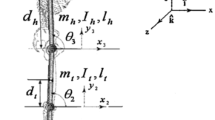Abstract
In this paper the result of a binational research, Mexico-Colombia, developed for the last four years is presented. This project aims to develop a robotic system to gait training for children 2 to 12 years with cerebral palsy. The concept design system and the methodology used during the development of the design process is presented. And finally, the optimal design of the ankle-foot stage is showed. The design of this stage was resolved as a dynamic optimization problem using a differential evolution algorithm with a constraint handling mechanism.
Preview
Unable to display preview. Download preview PDF.
Similar content being viewed by others
References
Borggraefe I., Schaefer J. S., Klaiber M., et al., (2010). Robotic-assisted treadmill therapy improves walking and standing performance in children and adolescents with cerebral palsy.European Journal of Pediatric Neurology,Vol. 14, pp. 496-502.
Meyer-Heim A., Ammann-Reiffer C., Schmartz A., Schaefer J., et al. (2009). Improvement of walking abilities after robotic-assisted locomotion training in children with cerebral palsy. Archives of disease in childhood, Vol. 94, pp. 615-620.
Kubo K., Miyoshi T., Kanai A. and Terashima1 K. (2011). Gait Rehabilitation Device in Central Nervous System Disease: A Review. Journal of Robotics. Vol. 2011, pp. 2-14.
Hesse S., Waldner A., Tomelleri C. (2010). Research Innovative gait robot for the repetitive practice of floor walking and stair climbing up and down in stroke patients. Journal Neuro Engineering and Rehabilitation, Vol 7, No. 30, pp. 1-10.
Canela M., Del Alma A. J., Pons J. L. (2013). Design of a pediatric exoskeleton for the rehabilitation of the physical disabilities caused by C.P. Converging Clinical &Engineering Research on NR. BIOSYSROB 1, pp. 255–258.
GhasemAbbasneiad, Jungwon Yoon, Hose Lee. (2016). Optimum kinematic design of a planar cable-driven parallel robot with wrench-closure gait trajectory. Mechanism and Machine Theory, Elsevier, Vol. 99, pp. 155–162.
Figueroa Amador M. T. (2016). Diseño de un sistema robótico para rehabilitación de marcha enfocado a niños con parálisis cerebral. Master’sThesis in Ingeniería de Manufactura, ESIME Azcapotzalco, IPN, Ciudad de México, México.
Calva-Yáñez M. B., Calderón-Romero F., Portilla-Flores E. A., Niño-Suarez P. A., Vega E. (2015). Diseño de mecanismo para seguimiento de trayectoria de tobillo en rehabilitación de marcha.In Proceeding MECAMEX, Queretaro, México.
Calva Y. M. B., Niño S. P. A., Villarreal C. M. G., et al. (2013). Differential Evolution for the Control Gain’s Optimal Tuning of a Four-bar Mechanism. POLIBITS, Vol. 47, pp. 67-73.
Ávila R., Prado L., and González E. (2001). Dimensiones antropométricas de población latinoamericana, Universidad de Guadalajara: Centro de Investigaciones en Ergonomía, pp. 24-276.
Author information
Authors and Affiliations
Corresponding author
Editor information
Editors and Affiliations
Rights and permissions
Copyright information
© 2017 Springer Nature Singapore Pte Ltd.
About this paper
Cite this paper
Niño Suarez, P.A., Calderon-Romero, F., Calva-Yañez, M.B., Portilla-Flores, E.A., Aviles-Sánchez, O.A. (2017). Optimal design of a mechanism for children foot guiding. In: Torres, I., Bustamante, J., Sierra, D. (eds) VII Latin American Congress on Biomedical Engineering CLAIB 2016, Bucaramanga, Santander, Colombia, October 26th -28th, 2016. IFMBE Proceedings, vol 60. Springer, Singapore. https://doi.org/10.1007/978-981-10-4086-3_180
Download citation
DOI: https://doi.org/10.1007/978-981-10-4086-3_180
Published:
Publisher Name: Springer, Singapore
Print ISBN: 978-981-10-4085-6
Online ISBN: 978-981-10-4086-3
eBook Packages: EngineeringEngineering (R0)




